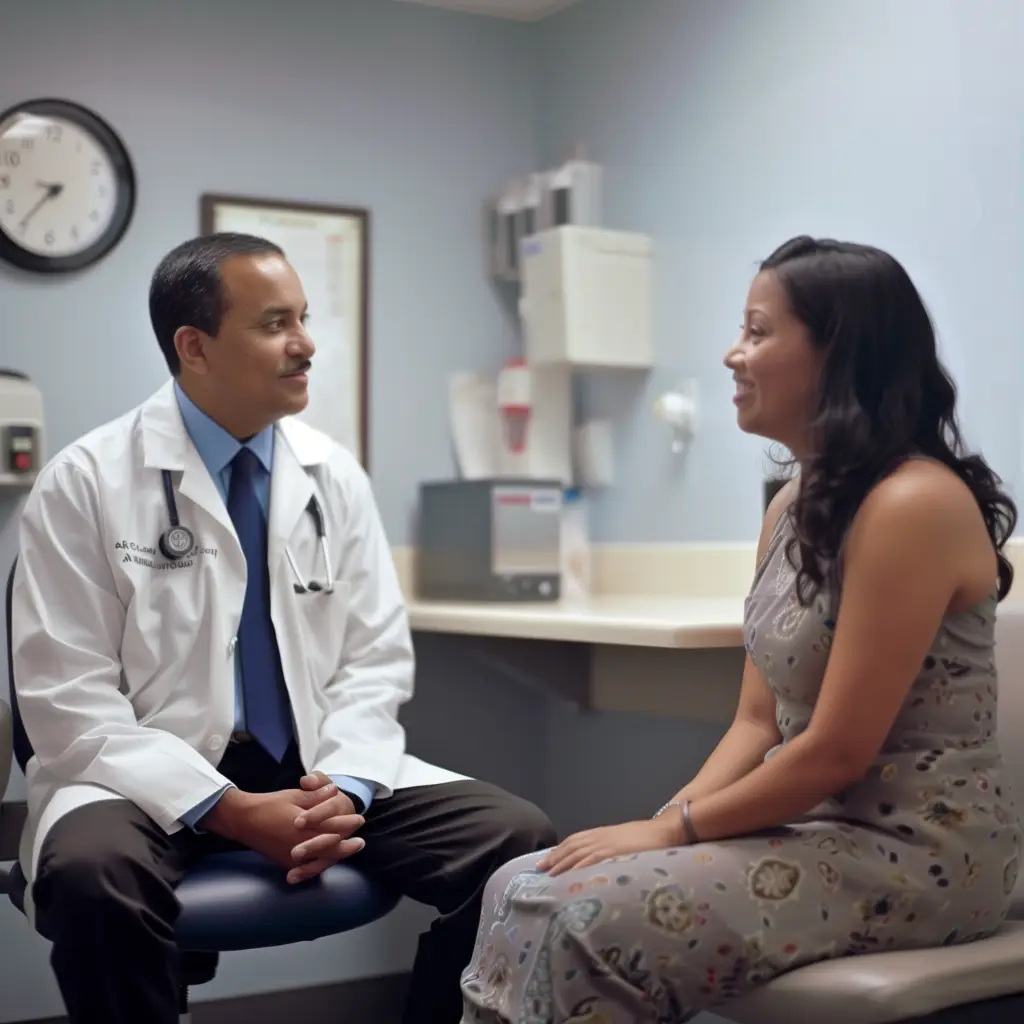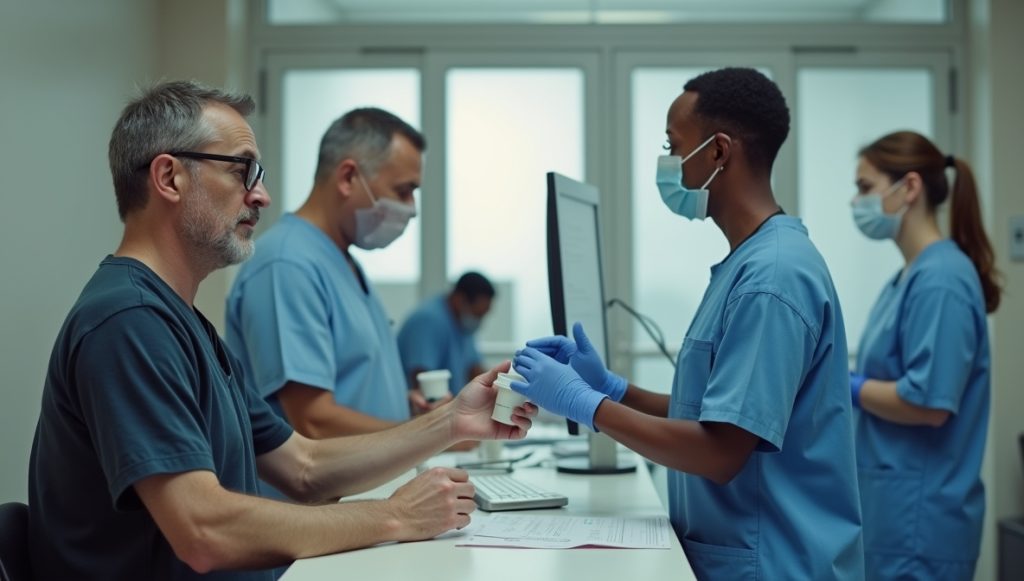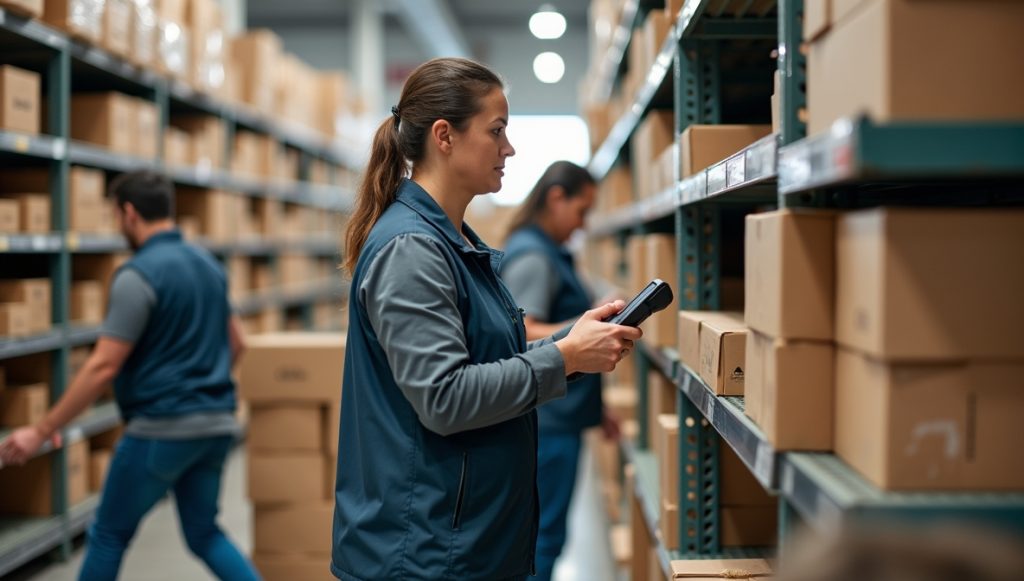Navigating the world of drug testing can be daunting for both employers and employees. Among the various testing methods available, drug mouth swab tests, also known as oral fluid tests, have become increasingly popular. They offer a non-invasive, quick, and reliable means to detect recent drug use, making them a favorite for business owners, HR professionals, and recruiters across many industries, from healthcare to technology. But how exactly do they work, and what should you know about them? This guide will demystify the process and provide valuable insights for both job seekers and employers.
Key Takeaways
- Drug mouth swab tests are non-invasive and efficient, primarily used for detecting recent drug use in workplace screenings.
- The test targets drug metabolites in saliva from substances like THC, cocaine, and opiates, offering quick results after a simple cheek swab.
- Detection windows for mouth swabs range from 24 to 72 hours, varying based on frequency of use and individual metabolism.
- Preparing for a mouth swab test involves abstaining from drugs, maintaining oral hygiene, and staying hydrated to potentially minimize detection.
- These tests are integral to employment health screenings, balancing safety, legality, and efficiency in workplace drug policies.
Introduction
What exactly is a drug mouth swab test? At its core, it's a straightforward and efficient method for detecting drug metabolites in saliva, used predominantly in pre-employment screenings and ongoing evaluations within the workplace. Employers favor this approach for its non-invasive nature and quick turnaround times. Industries like healthcare, staffing agencies, and transportation have standardized its use, thanks in part to its ability to catch recent substance use accurately. Consider this: statistics show a steady rise in adoption rates of oral fluid tests, underscoring their growing significance in today's employment landscape. This section provides a deeper understanding of why these tests have become such a staple in diverse professional environments.

How Do Drug Mouth Swab Tests Work?
A drug mouth swab test is all about simplicity and efficiency. At its core, the test detects drug metabolites in your saliva. Think of these metabolites as the remnants of substances your body has processed. When you use a drug, it breaks down into these smaller pieces, which then circulate in your bloodstream and, ultimately, into your saliva. The test typically targets substances like THC, cocaine, opiates, amphetamines, and a few others, focusing primarily on recent drug usage rather than long-term history.
The beauty of the mouth swab test lies in its collection process. It doesn't get much easier than swabbing the inside of your cheek. No needles, no cups – just a quick, painless swipe with a cotton swab. The collected sample goes off to a lab, where it's analyzed by professionals who know what to look for. The analysis is straightforward, making it a reliable choice for many workplaces. Within a few days – or even hours, depending on the lab's efficiency – results are back, providing a snapshot of an employee's recent substance use.
EXPERT INSIGHT: Drug mouth swab tests, also known as saliva drug tests, are increasingly popular for their ease of use, non-invasiveness, and quick results. This article provides a comprehensive overview of how these tests function and insights on common methods individuals might use to try to pass them. I recognize the critical role of drug testing in ensuring workplace safety and compliance. Mouth swab tests, capable of detecting recent drug use, are especially effective in identifying current state. This article serves as an invaluable resource for HR professionals, offering both technical understanding and practical guidance on implementing these tests effectively. - Emile Garcia, SHRM-SCP, CHRP, CHRBP
How Long Does it Take to Pass a Mouth Swab?
Mouth swab tests are the quick-draw specialists of drug screenings, designed to catch recent drug activity. So, when asking how long you need to steer clear of substances to pass one, it boils down to the detection windows, which tend to be pretty short. For most of the usual suspects like THC, cocaine, and opiates, you're looking at a window of about 24 to 48 hours. Some drugs, like amphetamines, might stretch up to 72 hours, but that's about as long as it lingers.
Now, why doesn't everyone get the same read? That's because several factors can tweak these timelines. If you're a frequent flyer with a particular substance, it might just hang around a little longer. Your body's metabolism plays a role, too; a fast metabolism may help you clear out quicker than a slow one. And last but not least, staying hydrated can dilute your saliva, potentially affecting concentration levels of drug metabolites present, though it's not a foolproof tactic.
So, in a nutshell: if you've indulged in something this week and have a swab test coming up, there's a chance it might show. Plan your timing wisely if you're in the hiring lane or just maintaining your spot on the team.
What Shows Up on a Drug Mouth Swab Test?
Mouth swab tests are popular for their ability to detect recent drug use effectively. They usually screen for a range of substances. The most common drugs detectable by this method include THC, amphetamines, cocaine, opiates, and sometimes benzodiazepines. These substances leave metabolites in saliva, which the swab picks up and sends for analysis. This type of test is particularly effective at identifying usage within a short time frame, generally from a few hours to a couple of days.
The scope of what shows up on a swab can vary depending on the test used and the jurisdiction. For instance, in Australia, there's an ongoing conversation about how CBD might figure into testing. Generally, CBD itself isn't flagged during routine drug screenings since it's non-psychoactive. However, impurities or THC traces in CBD products may cause a positive result, a factor influenced by regional testing guidelines.
As for THC lotions and other topicals, they're unlikely to result in a positive on a mouth swab test. These products typically don't affect saliva, given they're applied externally and not ingested. However, caution should be exercised with any product that could inadvertently enter the bloodstream or saliva during use.
Understanding which substances can be detected and how they might end up in a swab test is crucial for both employees and employers in navigating drug testing procedures and implications properly.
Preparing for a Drug Mouth Swab Test
Before the Test
When facing an upcoming mouth swab test, a little preparation goes a long way. Start with the obvious: avoid drugs in the days leading up to the test. While it might sound straightforward, this simple step is the most effective. Beyond abstinence, ramp up your efforts in maintaining oral hygiene. Brush your teeth several times a day and don’t forget the cheeks, gums, and tongue—the hidden nooks where residues might linger. A final swish of mouthwash can’t hurt either; some people swear by it, though keep in mind it’s no guarantee.
Hydration plays a subtle yet significant role. Staying hydrated can potentially reduce the concentration of drug metabolites in your saliva. Water is your best friend here. Sip regularly. Gum or mints can also stimulate saliva production, keeping your mouth in a constant state of clean.
Non CDL DOT Physical Drug Test
If you're in a role that encompasses transportation but skirts around CDL regulations—think non-CDL drivers or those involved with public service vehicles—understanding specific drug testing criteria is key. These tests may not differ wildly from regular mouth swab ones, but they do maintain a strict adherence to DOT standards. What's typically expected? A thorough inquiry into recent drug use similar to any other setting, but with an added emphasis on safety-sensitive stipulations due to the nature of the work. Make your choices wisely, knowing that this type of job has its own steadfast rules.
What is a Health Screening for a Job?
Health screenings for jobs often extend beyond drug tests to encompass a variety of checks intended to assess the overall health picture of an applicant. Components typically include a physical examination which evaluates vital signs, eyesight, hearing, and other basic health indicators. Blood pressure readings, cholesterol levels, and glucose levels may be checked, offering insights into the candidate's cardiovascular and metabolic health.
The overall purpose is to ensure an applicant is physically capable of performing job duties, particularly in roles demanding physical activity or high safety awareness. For employers, these screenings help mitigate risks of workplace accidents or health-related absences. For candidates, these assessments provide an opportunity to understand their health better, potentially flagging issues before they become significant problems.
What Happens if You Fail a Drug Test?
Failing a drug test can feel like an insurmountable hurdle, but understanding the repercussions can help manage the situation. For job seekers, a failed test typically means the end of the road with a potential employer. It's often a deal-breaker, leading to the rescission of a job offer or the denial of employment altogether. Current employees might face disciplinary action, which can vary widely depending on company policy. Some organizations mandate immediate termination, while others might offer support programs or a second chance.
Employers must tread carefully in these situations, balancing the need for a safe and compliant workplace with fair treatment of employees. Legal and ethical considerations come into play, with guidelines from the EEOC directing how to handle such sensitive information. Employers must ensure that their actions do not violate anti-discrimination laws and that they maintain confidentiality throughout the process.
Navigating a failed drug test isn't easy, but both employees and employers benefit from understanding and adhering to established policies. Ultimately, clear communication and awareness of rights and responsibilities can ease the strain on both sides.
Do Pre-Employment Drug Screens Test for Alcohol?
When it comes to pre-employment drug screening, alcohol testing isn't always part of the package. Typically, these tests zero in on substances like THC, cocaine, opiates, and amphetamines, given their impact on workplace safety and performance. However, it's not entirely off the table. Employers, especially those in safety-sensitive industries like transportation or construction, might throw alcohol into the mix. The reasoning? They're not just checking for chronic misuse but any evidence of alcohol in your system could suggest recent consumption.
So, why the variance in testing? It often boils down to the nature of the job and company policy. Some employers may choose to keep alcohol out of routine panels, potentially due to cost considerations or because their primary focus is on controlled substances. In other cases, especially where workplace safety heavily dictates policy, detecting alcohol becomes a priority.
For job seekers, it's crucial to anticipate either scenario. Understanding a prospective employer's stance on alcohol testing could mean the difference between preparedness and surprise. It’s always good to check the specific testing protocols used by the company you’re applying to, as assumptions can sometimes miss the mark.
Cost Considerations in Drug Testing
When it comes to drug testing, cost is often a major consideration for employers looking to implement a testing policy. While the focus is on mouth swab tests, it’s useful to compare with urine tests, another popular option that many businesses use.
A urine drug screen can typically range from $30 to $70 per test, depending on factors like the panel size (the number of substances tested for), location, and whether it's conducted in-house or through a third-party lab. Larger panels that test for a broader range of substances inevitably cost more.
Employers need to weigh their testing needs against these costs. For businesses in industries like transportation or healthcare, where safety and compliance demands are high, the investment in a comprehensive drug screening might be justified. Furthermore, understanding the intricacies of these costs can aid in budgeting and ensure a fair assessment process.
By considering these variables, companies can choose the most cost-effective and suitable drug testing method that aligns with their specific policy goals.
Do CBG and Other Cannabinoids Show Up on Drug Tests?
When it comes to drug testing, particularly mouth swab tests, the focus typically centers on THC, the primary psychoactive compound in cannabis. However, recent years have seen a surge in interest in other cannabinoids like CBG (Cannabigerol). Unlike THC, CBG doesn't have psychoactive effects, and it's found in much smaller quantities in most cannabis strains. So, does CBG or other non-psychoactive cannabinoids show up on these tests?
Here's the simple answer: not usually. Drug tests, including mouth swabs, are primarily designed to detect THC and its metabolites. CBG and cannabinoids like CBD (Cannabidiol) don't produce the same metabolites, which means they're generally not the target in standard drug tests. However, it's crucial to understand that the specificity of drug tests can vary. Some highly specialized tests might be able to pick up a broader spectrum of cannabinoids, although this is not common practice or cost-effective for most employers.
In the end, while it's unlikely that a standard mouth swab will detect CBG, being cautious and informed remains the best policy, particularly as testing technologies evolve.
Conclusion
Understanding drug mouth swab tests is crucial for navigating today's employment landscape, whether you're a job seeker aiming to pass a test or an employer establishing screening procedures. These tests offer a quick and efficient way to detect recent drug use, marking them as an essential tool for many industries. While the science behind the test is straightforward—identifying drug metabolites in saliva—the implications are significant for all parties involved.
For those preparing to take a mouth swab test, awareness of detection windows and factors that influence results can be empowering. Simple strategies, like maintaining oral hygiene and knowing what substances to avoid, can make a difference. Employers, meanwhile, benefit from incorporating such tests into broader health screenings, ensuring a safer and more compliant workplace.
Ultimately, drug mouth swab tests serve as a checkpoint at the intersection of health, legality, and workplace efficiency. By demystifying this process, both individuals and businesses can foster environments that are both productive and transparent, paving the way for informed and confident decision-making.
Frequently Asked Questions (FAQs)
How accurate are mouth swab drug tests compared to urine tests?
Mouth swab drug tests are generally less invasive and can provide quick results, but they have a shorter detection window compared to urine tests. While they are accurate for recent substance use (typically within 24-48 hours), urine tests can detect drug use over a longer period, often several days to weeks depending on the substance.
Can mouth swab drug tests be affected by food or drink?
Yes, mouth swab drug tests can be temporarily influenced by food or drink. It's advised to avoid eating or drinking anything other than water for at least 10-15 minutes before taking the test to prevent potential interference with the results.
How soon after drug use can a mouth swab test detect substances?
Mouth swab drug tests can usually detect substances within minutes to a few hours after use. This makes them particularly effective for identifying recent drug use, providing a snapshot of current intoxication levels or very recent consumption.
Are there any methodologies to fool a mouth swab drug test?
There are various myths and claims about ways to fool a mouth swab drug test, such as using mouthwash or other products. However, these methods are generally unreliable. The best way to pass a drug test is to not ingest the substances being tested for. Testing protocols are designed to minimize the chance of interference, and confirmatory testing can be employed to verify initial results.
Still have questions?
Get in touch with our team today for a personalized demo and discover how our tailored volume pricing and packages can drive results for your business!
How useful was this page?*
Note: your comments are anonymous. We use them to improve the website. Do not include any personal details.
Visit our FCRA Compliance Tool or leave a message here if you need a response.
From the blog Explore the GCheck Content Hub

Prescription Drugs That Show Up on Drug Tests: A Compliance Guide
4 Dec, 2025 • 18 min read
Seasonal Employee Background Checks: Protecting Your Business During Peak Hiring Periods
4 Dec, 2025 • 22 min read
Background Check for Volunteers vs Employees: Legal Frameworks and Screening Protocol Development
3 Dec, 2025 • 14 min readThe information provided in this article is for general informational and educational purposes only and should not be construed as legal advice or a substitute for consultation with qualified legal counsel. While we strive to ensure accuracy, employment screening laws and regulations—including but not limited to the Fair Credit Reporting Act (FCRA), Equal Employment Opportunity Commission (EEOC) guidelines, state and local ban-the-box laws, industry-specific requirements, and other applicable federal, state, and local statutes—are subject to frequent changes, varying interpretations, and jurisdiction-specific applications that may affect their implementation in your organization. Employers and screening decision-makers are solely responsible for ensuring their background check policies, procedures, and practices comply with all applicable laws and regulations relevant to their specific industry, location, and circumstances. We strongly recommend consulting with qualified employment law attorneys and compliance professionals before making hiring, tenant screening, or other decisions based on background check information.


